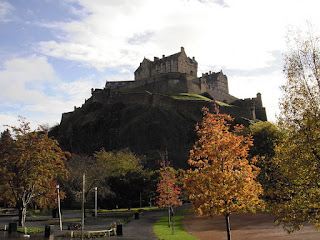Gretna Green is infamous for runaway marriages that were performed by its local blacksmith. Gretna is located in the south of Scotland. Today, this picturesque village is frequented by tourists on their way to Edinburgh.
Edinburgh:
Like London, the capital of Scotland – Edinburgh, has a rich history, mystery and tradition. It is perched on several extinct volcanoes and rocky crags with the Firth of Forth to the north.
- The Palace of Holyroodhouse, or informally Holyrood Palace, founded as a monastery by David I of Scotland in 1128, has served as the principal residence of the Kings and Queens of Scotland since the 15th century. The Palace stands in Edinburgh at the bottom of the Royal Mile.
 |
| Edinburgh Castle in Autumn, Photo Image © Wikipedia |
Stirling:
Originally a Stone Age Settlement, Stirling has been strategically significant since at least the Roman occupation of part of Britain, due to its easily defensible hill (latterly the site of Stirling Castle) and its commanding position beside the River Forth. Stirling Castle sits atop the Castle Hill, a volcanic crag, and is surrounded on three sides by steep cliffs, making it easily defensible. This fact, and its strategic position, have made it an important fortification from the earliest times.
 |
| The Wallace Monument, near Stirling Castle, Photo Image © Wikipedia |
The renaissance Chapel Royal on the north side of the upper court was used for the coronation of the Queen of Scotland, Mary Queen of Scots, when she was 9 years old, in 1543.
Near Stirling, on summit of Abbey Craig, stands a tower known as the Wallace Monument, that commemorates Sir William Wallace, the 13th century Scottish Hero.
Balmoral Castle is a large estate house situated in the area of Aberdeenshire, Scotland known as Royal Deeside. The estate was purchased by Queen Victoria's consort Prince Albert, and remains a favorite summer royal residence.
Inverness:
Inverness lies at the mouth of the River Ness as it flows into the Moray Firth in north-east Scotland. The river flows from nearby Loch Ness and the Caledonian Canal connects Loch Ness, Loch Oich, and Loch Lochy. To enjoy this city, take a walk along the river Ness.
It is the base of which one would visit take a day trip to visit the Urquhart Castle and cruise up the Caledonian Canal from Loch Ness.
Loch Ness:
The Loch Ness is a large deep freshwater lake in the Scottish Highlands, extending for 37km southwest of Inverness. It is most well known for its legend of the Loch Ness Monster, affectionately named Nessie.
 |
| Cruising on Loch |
 |
Fort William:
 |
The Ben, as it is affectionately called by locals, is a favourite destination for walkers and climbers, as it suitable tracks on the south side for walkers and high cliffs on the north face for climbers and mountaineers.


No comments:
Post a Comment